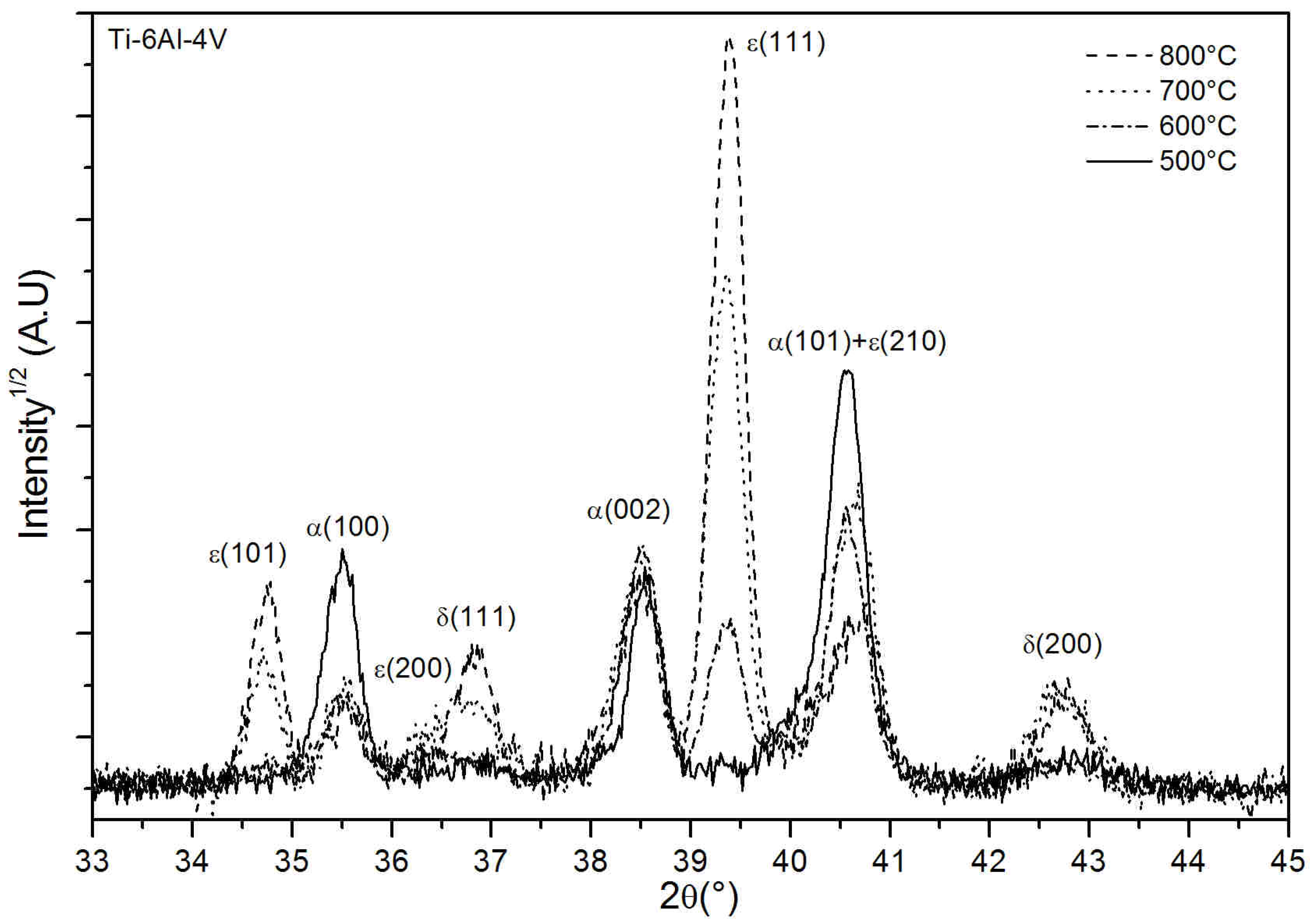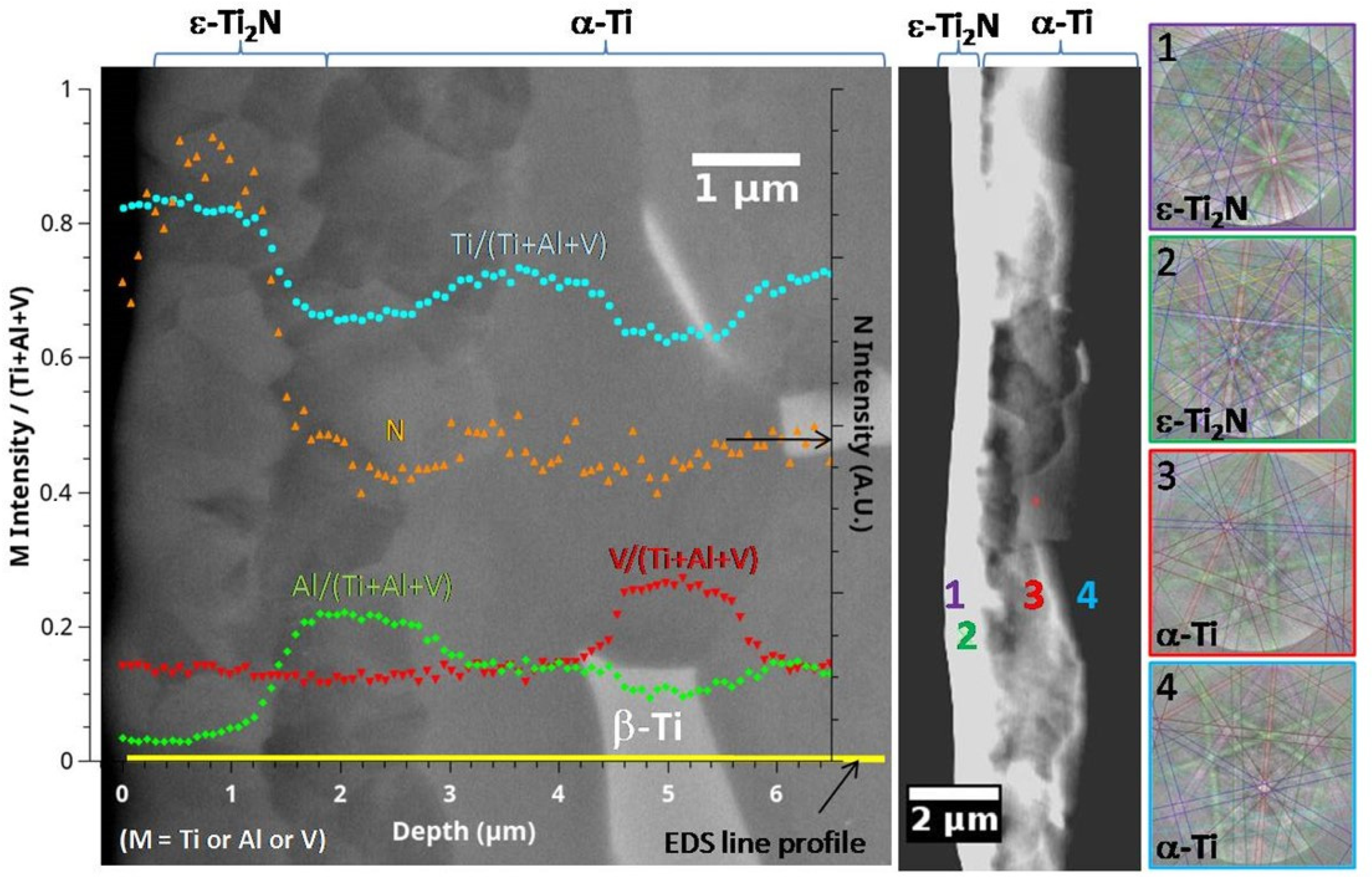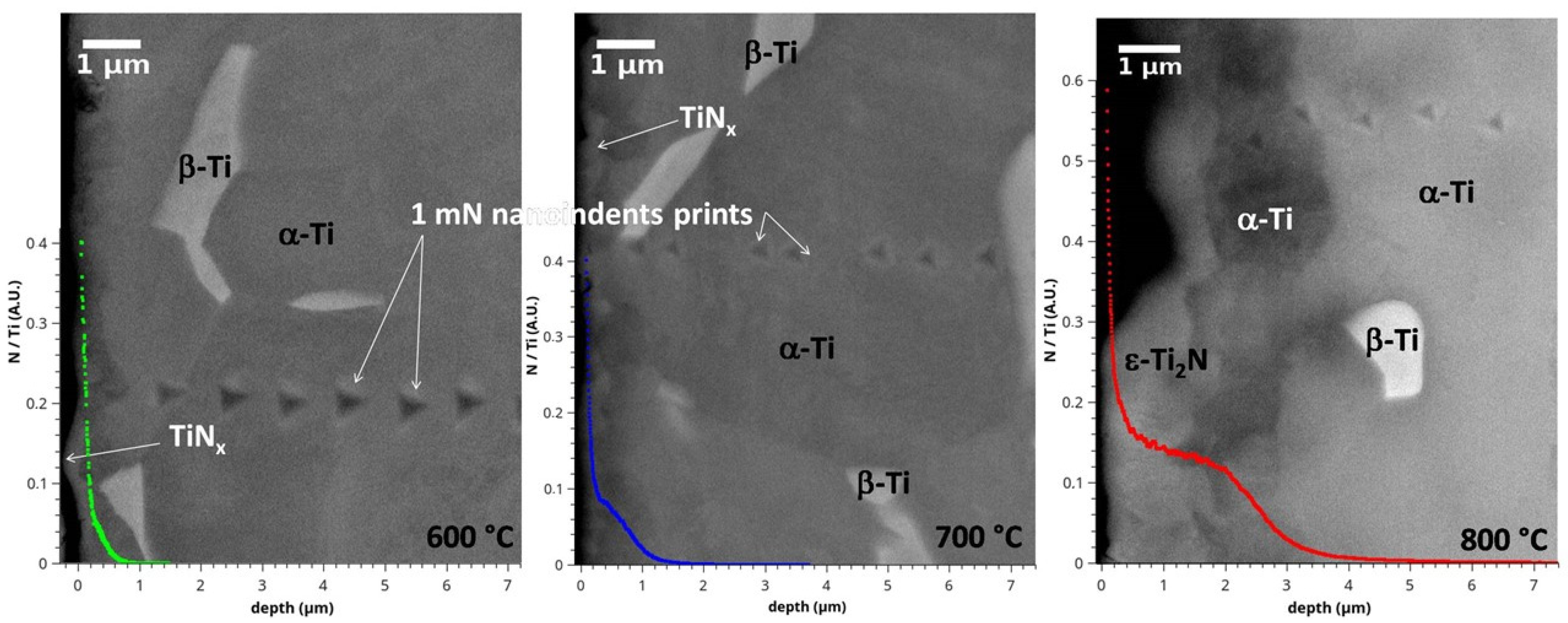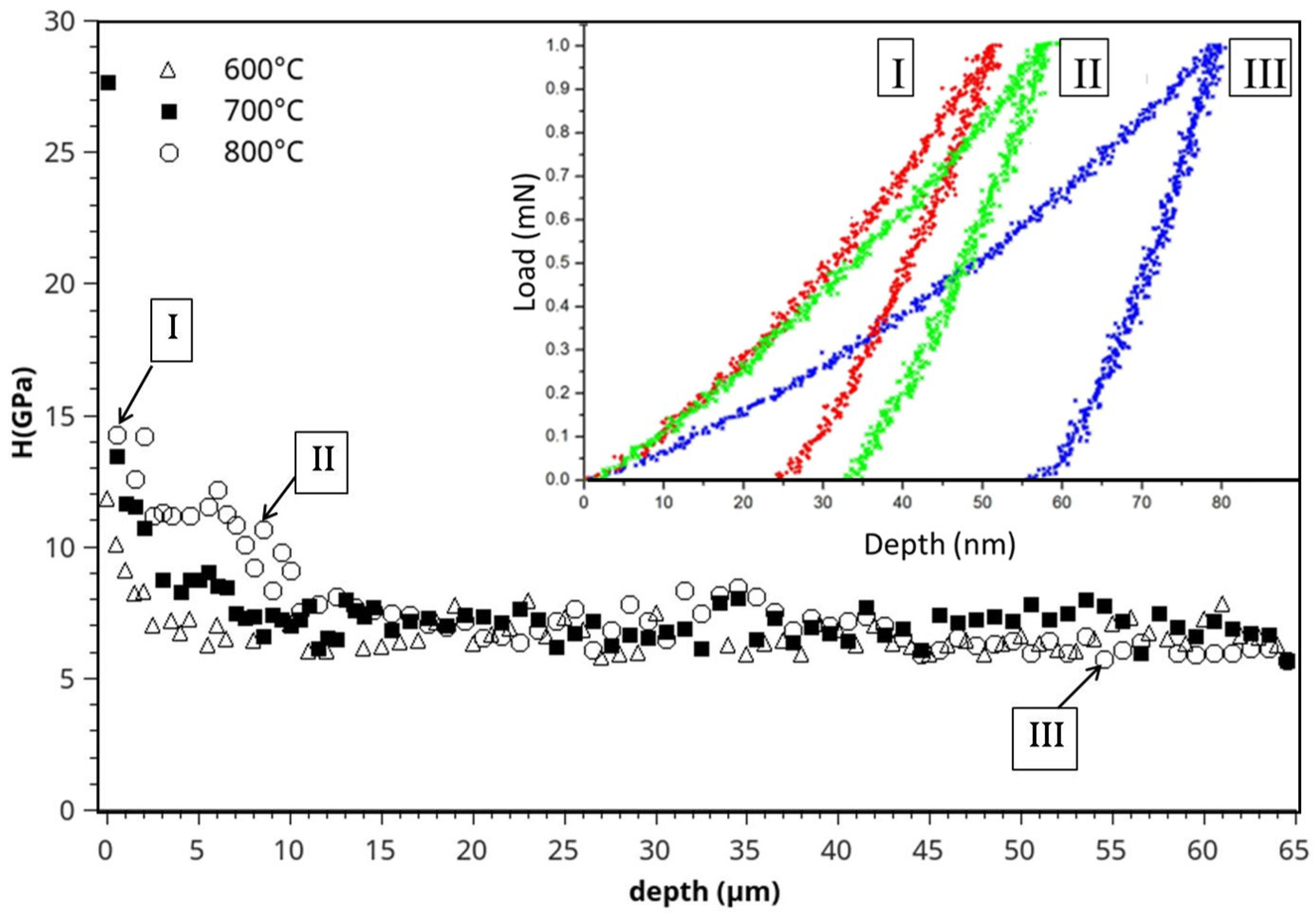Relation between Mechanical Hardening and Nitrogen Profile of PBII Nitrided Titanium Alloy
Abstract
1. Introduction
2. Experimental Techniques
2.1. Material and Nitriding
2.2. Structural Characterizations
2.3. Mechanical Characterization
3. Results and Discussion
3.1. Structural Characterizations
3.2. Mechanical Properties
4. Conclusions
Supplementary Materials
Author Contributions
Funding
Data Availability Statement
Conflicts of Interest
References
- Zhecheva, A.; Sha, W.; Malinov, S.; Long, A. Enhancing the microstructure and properties of titanium alloys through nitriding and other surface engineering methods. Surf. Coat. Technol. 2005, 200, 2192–2207. [Google Scholar] [CrossRef]
- da Silva, J.S.P.; Amico, S.C.; Rodrigues, A.O.N.; Barboza, C.A.G.; Alves, C.; Croci, A.T. Osteoblastlike Cell Adhesion on Titanium Surfaces Modified by Plasma Nitriding. Int. J. Oral Maxillofac. Implant. 2011, 26, 237–244. [Google Scholar]
- Clem, W.C.; Konovalov, V.V.; Chowdhury, S.; Vohra, Y.K.; Catledge, S.A.; Bellis, S.L. Mesenchymal stem cell adhesion and spreading on microwave plasma-nitrided titanium alloy. J. Biomed. Mater. Res. Part A 2005, 76A, 279–287. [Google Scholar] [CrossRef] [PubMed]
- Oliveira, V.; Cioffi, M.; Barboza, M.; Landers, R.; Schmitt, B.; Tapia, D.; Voorwald, H. Plasma immersion ion implantation (piii) influence on ti-6al- 4v alloy: Frequency effect. Int. J. Fatigue 2018, 109, 157–165. [Google Scholar] [CrossRef]
- Takesue, S.; Kikuchi, S.; Akebono, H.; Morita, T.; Komotori, J. Characterization of surface layer formed by gas blow induction heating nitriding at different temperatures and its effect on the fatigue properties of titanium alloy. Results Mater. 2020, 5, 100071. [Google Scholar] [CrossRef]
- Fouquet, V.; Pichon, L.; Drouet, M.; Straboni, A. Plasma assisted nitridation of Ti-6Al-4V. Appl. Surf. Sci. 2004, 221, 248–258. [Google Scholar] [CrossRef]
- Hainsworth, S.; Soh, W. The effect of the substrate on the mechanical properties of tin coatings. Surf. Coat. Technol. 2003, 163–164, 515–520. [Google Scholar] [CrossRef]
- Lanzutti, A.; Raffaelli, A.; Magnan, M.; Fedrizzi, L.; Regis, M.; Marin, E. Microstructural and mechanical study of an induction nitrided Ti gr.5 hip prosthesis component. Surf. Coat. Technol. 2019, 377, 124895. [Google Scholar] [CrossRef]
- Morita, T.; Takahashi, H.; Shimizu, M.; Kawasaki, K. Factors controlling the fatigue strength of nitrided titanium. Fatigue Fract. Eng. Mater. Struct. 1997, 20, 85–92. [Google Scholar] [CrossRef]
- Costescu, C.I.; Heuser, B.J. The effect of a nitrogen-rich surface layer on the sub-surface deuterium (hydrogen) concentration distribution in titanium. Surf. Sci. 2000, 450, 242–250. [Google Scholar] [CrossRef]
- Wilson, A.; Leyland, A.; Matthews, A. A comparative study of the influence of plasma treatments, PVD coatings and ion implantation on the tribological performance of Ti-6Al-4V. Surf. Coat. Technol. 1999, 114, 70–80. [Google Scholar] [CrossRef]
- Alipour, R.; Khani, A.A.; Mohammadi, R.; Rostami, S. The effect of formation of titanium nitride thin film on surface characteristics of titanium by nitrogen ion implantation. J. Chem. Res. 2016, 40, 12–15. [Google Scholar] [CrossRef]
- Yas’kiv, O.I.; Pohrelyuk, I.M.; Fedirko, V.M.; Bonchyk, O.Y.; Kravchyshyn, T.M. Properties and structural-phase state of the surface layers of titanium after combined nitriding. Mater. Sci. 2007, 43, 370–376. [Google Scholar] [CrossRef]
- Aghajani, H.; Motlagh, M.S. Effect of temperature on surface characteristics of nitrogen ion implanted biocompatible titanium. J. Mater. Sci. Mater. Med. 2017, 28, 29. [Google Scholar] [CrossRef] [PubMed]
- Collins, G.; Hutchings, R.; Short, K.; Tendys, J. Ion-assisted surface modification by plasma immersion ion implantation. Surf. Coat. Technol. 1998, 104, 212–217. [Google Scholar] [CrossRef]
- Marot, L.; Le Bourhis, E.; Straboni, A. Improved nitridation efficiency and mechanical property of stainless steel surface after N-2-H-2 plasma nitridation at low temperature. Mater. Lett. 2002, 56, 76–79. [Google Scholar] [CrossRef]
- Morita, R.; Azuma, K.; Inoue, S.; Miyano, R.; Takikawa, H.; Kobayashi, A.; Fujiwara, E.; Uchida, H.; Yatsuzuka, M. Corrosion resistance of tin coatings produced by various dry processes. Surf. Coat. Technol. 2001, 136, 207–210, proceedings of the Fifth International Conference on Plasma-Based Ion Implantation. [Google Scholar] [CrossRef]
- Lacoste, A.; Béchu, S.; Arnal, Y.; Pelletier, J.; Vallée, C.; Gouttebaron, R.; Stoquert, J. Nitrogen profiles in materials implanted via plasma-based ion implantation. Surf. Coat. Technol. 2002, 156, 125–130. [Google Scholar] [CrossRef]
- Berberich, F.; Matz, W.; Kreissig, U.; Richter, E.; Schell, N.; Moller, W. Structural characterisation of hardening of Ti-Al-V alloys after nitridation by plasma immersion ion implantation. Appl. Surf. Sci. 2001, 179, 13–19. [Google Scholar] [CrossRef]
- Geng, Y.; McCarthy, E.; Brabazon, D.; Harrison, N. Ti6al4v functionally graded material via high power and high speed laser surface modification. Surf. Coat. Technol. 2020, 398, 126085. [Google Scholar] [CrossRef]
- Stratton, P.; Graf, M. Wear of diffusion hardened Ti–6Al–4V sliding against tool steel. Wear 2010, 268, 612–616. [Google Scholar] [CrossRef]
- Johns, S.; Bell, T.; Samandi, M.; Collins, G. Wear resistance of plasma immersion ion implanted Ti6Al4V. Surf. Coat. Technol. 1996, 85, 7–14. [Google Scholar] [CrossRef]
- Alonso, F.; Rinner, M.; Loinaz, A.; O˜nate, J.; Ensinger, W.; Rauschenbach, B. Characterization of ti-6a1-4v modified by nitrogen plasma immersion ion implantation. Surf. Coat. Technol. 1997, 93, 305–308. [Google Scholar] [CrossRef]
- Fouquet, V.; Le Bourhis, E.; Pichon, L.; Drouet, M.; Straboni, A. Elastic– plastic resistance profile of pbii nitrided titanium. Scr. Mater. 2004, 51, 899–903. [Google Scholar] [CrossRef]
- Drouet, M.; Pichon, L.; Dubois, J.; Bourhis, E.L.; Christiansen, T. Surface engineering of titanium by multi-interstitial diffusion using plasma processing. MATEC Web Conf. 2020, 321, 11010. [Google Scholar] [CrossRef]
- Barbieri, F.; Otani, C.; Lepienski, C.; Urruchi, W.; Maciel, H.; Petraconi, G. Nanoindentation study of Ti6Al4V alloy nitrided by low intensity plasma jet process. Vacuum 2002, 67, 457–461. [Google Scholar] [CrossRef]
- Berberich, F.; Matz, W.; Richter, E.; Schell, N.; Kreisig, U.; Möller, W. Structural mechanisms of the mechanical degradation of ti–al–v alloys: In situ study during annealing. Surf. Coat. Technol. 2000, 128–129, 450–454. [Google Scholar] [CrossRef]
- Meletis, E.; Cooper, C.; Marchev, K. The use of intensified plasma-assisted processing to enhance the surface properties of titanium. Surf. Coat. Technol. 1999, 113, 201–209. [Google Scholar] [CrossRef]
- Kunert, M.; Baretzky, B.; Baker, S.; Mittemeijer, E. Hardness-depth profiling on nanometer scale. Metall. Mater. Trans. A Phys. Metall. Mater. Sci. 2001, 32, 1201–1209. [Google Scholar] [CrossRef]
- Marot, L.; Drouet, M.; Berneau, F.; Straboni, A. High temperature plasma based ionic implantation of titanium alloys and silicon. Surf. Coat. Technol. 2002, 156, 155–158. [Google Scholar] [CrossRef]
- Le Bourhis, E. Glass Mechanics and Technology, 2nd ed.; Wiley: Weinheim, Germany, 2014. [Google Scholar]
- Bars, J.; Etchessahar, E.; Debuigne, J. Kinetics, diffusion and morphology of Titanium nitriding using high-temperature nitrogen—Mechanical and structural properties of solid Ti-alpha-nitrogen solutions. J. Less-Common Met. 1977, 52, 51–76. [Google Scholar] [CrossRef]
- Lee, H.; Kang, H.; Kim, J.; Shin, H.-K.; Lee, J.; Huh, S.-H.; Sung, J.; Lee, H.-J. Inward diffusion of al and ti3al compound formation in the ti–6al–4v alloy during high temperature gas nitriding. Surf. Coat. Technol. 2014, 240, 221–225. [Google Scholar] [CrossRef]
- Morgiel, J.; Wierzcho’n, T. New estimate of phase sequence in diffusive layer formed on plasma nitrided ti-6al-4v alloy. Surf. Coat. Technol. 2014, 259, 473–482. [Google Scholar] [CrossRef]
- Tromas, C.; Stinville, J.C.; Templier, C.; Villechaise, P. Hardness and elastic modulus gradients in plasma-nitrided 316L polycrystalline stainless steel investigated by nanoindentation tomography. Acta Mater. 2012, 60, 1965–1973. [Google Scholar] [CrossRef]
- Patsalas, P.; Charitidis, C.; Logothetidis, S. The effect of substrate temperature and biasing on the mechanical properties and structure of sputtered titanium nitride thin films. Surf. Coat. Technol. 2000, 125, 335–340. [Google Scholar] [CrossRef]
- Musil, J. Hard and superhard nanocomposite coatings. Surf. Coat. Technol. 2000, 125, 322–330. [Google Scholar] [CrossRef]
- Guemmaz, M.; Mosser, A.; Ahuja, R.; Parlebas, J. Theoretical and experimental investigations on elastic properties of substoichiometric titanium nitrides: Influence of lattice vacancies. Int. J. Inorg. Mater. 2001, 3, 1319–1321. [Google Scholar] [CrossRef]




| Element | Ti | Al | V | O | Fe | C | N |
|---|---|---|---|---|---|---|---|
| Ti-6Al-4V | Bal. | 5.5–6.75 | 3.5–4.5 | 0.2 | 0.4 | 0.1 | 0.05 |
Publisher’s Note: MDPI stays neutral with regard to jurisdictional claims in published maps and institutional affiliations. |
© 2022 by the authors. Licensee MDPI, Basel, Switzerland. This article is an open access article distributed under the terms and conditions of the Creative Commons Attribution (CC BY) license (https://creativecommons.org/licenses/by/4.0/).
Share and Cite
Parry, V.; Le Bourhis, E.; Pichon, L.; Drouet, M. Relation between Mechanical Hardening and Nitrogen Profile of PBII Nitrided Titanium Alloy. Materials 2022, 15, 9028. https://doi.org/10.3390/ma15249028
Parry V, Le Bourhis E, Pichon L, Drouet M. Relation between Mechanical Hardening and Nitrogen Profile of PBII Nitrided Titanium Alloy. Materials. 2022; 15(24):9028. https://doi.org/10.3390/ma15249028
Chicago/Turabian StyleParry, Valérie, Eric Le Bourhis, Luc Pichon, and Michel Drouet. 2022. "Relation between Mechanical Hardening and Nitrogen Profile of PBII Nitrided Titanium Alloy" Materials 15, no. 24: 9028. https://doi.org/10.3390/ma15249028
APA StyleParry, V., Le Bourhis, E., Pichon, L., & Drouet, M. (2022). Relation between Mechanical Hardening and Nitrogen Profile of PBII Nitrided Titanium Alloy. Materials, 15(24), 9028. https://doi.org/10.3390/ma15249028







